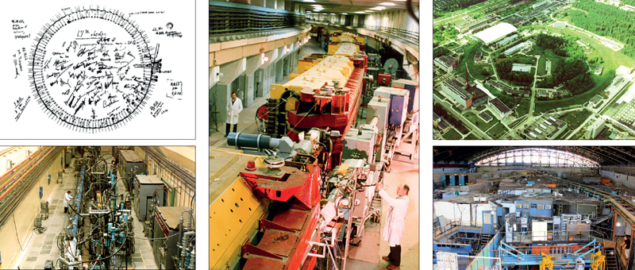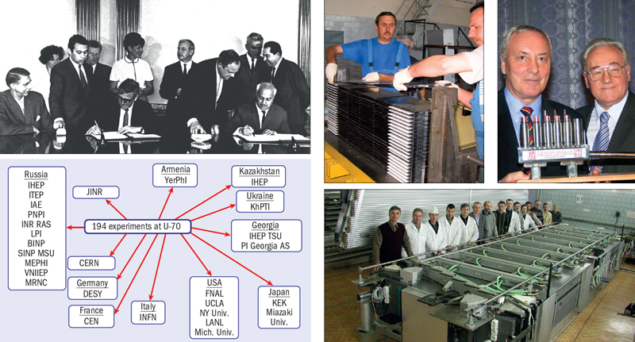IHEP celebrates its 50th anniversary.

Image credits: IHEP.
The Institute for High Energy Physics (IHEP), Protvino, was established as a new Soviet particle-physics laboratory 50 years ago in November 1963. Four years later, the 70-GeV proton synchrotron U-70 – which became known as the “Serpukhov accelerator” – was commissioned, reaching a world-record proton energy of 76 GeV on the night of 14 October 1967. Physics research started at the beginning of 1968, conducted by several groups with unprecedented international participation for that time, in teams from CERN and the French Atomic Energy Commission (the CEA).
Only four years had passed since the theoretical proposal of quarks as elementary constituents of matter, so searching for them in the new energy range became one of the top priorities for the experiments at the U-70. Free quarks were not found but this negative result appears to have been the first of a long list from similar attempts that resulted finally in the well-known hypothesis of quark confinement.
Meanwhile, among many interesting new results that were obtained at the IHEP accelerator during its first years of operation, two in particular stand out: discovery of the growth of hadronic cross-sections with energy and the scaling behaviour of hadronic inclusive distributions. It is worth noting that both phenomena are poorly understood still, even in the framework of modern theory.
Today, IHEP is continuing to carry out a programme of fundamental research at the U-70 in the areas where the accelerator’s parameters offer the opportunity for significant outcomes. In particular, the upgrade of the accelerator complex for higher intensity will create a unique beamline of separated K mesons and a new experimental facility OKA for an extensive programme of research with kaons.
The current physics research programme covers a variety of topics. The spectroscopy of mesons and baryons is served by several experimental facilities: VES, SVD, HYPERON and MIS-ITEP. The search for rare decays of K mesons and for CP violation is the focus for ISTRA+ as well as for OKA. The study of the structure of nucleons takes place with polarized beams in the Spin Asymmetry in Charm production (SPASCHARM) experiment and the FODS double-arm spectrometer, while FODS also investigates hard processes. Last, the SPIN experiment is looking at the properties of baryonic matter. In theoretical particle physics, the main achievements and current activities of the IHEP physicists are related to the physics of heavy quarks, strong interactions at high energies, quantum field theory, gravitation and cosmology.

Alongside the fundamental physics research, IHEP also undertakes extensive studies in accelerator physics and technology. Here, the principle and techniques of radio-frequency quadrupole (RFQ) acceleration proposed and developed at IHEP have been one of the notable achievements in accelerator science. IHEP also put forward the use of bent-crystal deflectors for the extraction of particle beams and for collimation. This technique is now widely used at the U-70 accelerator as well as at Fermilab and at CERN.
An important recent achievement at the U-70 was the commissioning in 2010 of stochastic slow beam extraction, which has significantly improved the performance of the machine and increased the efficiency of the experiments. Since 2011, the U-70 has been upgraded to accelerate carbon nuclei to 24.1–34.1 GeV per nucleon. This has allowed IHEP to proceed with experiments in the field of fixed-target relativistic nuclear physics.
In the area of applications, in 2004–2010 IHEP developed and constructed a unique proton radiography facility, which has been successfully used in co-operation with physicists from the All-Russian Research Institute of Experimental Physics (VNIIEF) in Sarov. In 2011, the U-70 received a new slow-extraction system at flat bottom, which delivers a beam of carbon nuclei at 450–455 MeV per nucleon for applied research.
Last but not least, IHEP contributes significantly in broad international collaborations with CERN, Fermilab and Brookhaven National Laboratory. Examples include the production of an endcap muon wall for the DØ experiment at Fermilab’s Tevatron, an electromagnetic calorimeter for the PHENIX experiment at Brookhaven’s Relativistic Heavy-Ion Collider, electrical feedboxes, dump resistors, septum magnets and beam-loss monitors for CERN’s LHC, monitored drift-tube chambers and tiles for hadron calorimetry in the ATLAS detector at the LHC, crystals for electromagnetic calorimetry in the CMS experiment, and modules for LHCb’s hadron calorimeter. IHEP is also a Tier-2 site in the Wordwide LHC Computing Grid.





